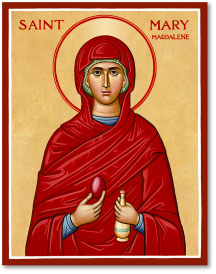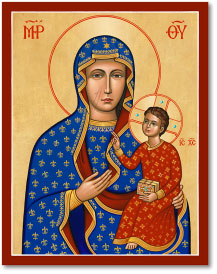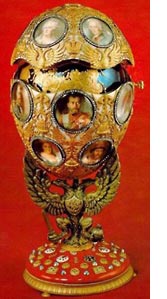Before the egg became closely entwined with the Christian Easter, it was honored during many rite-of-Spring festivals. The Romans, Gauls, Chinese, Egyptians and Persians all cherished the egg as a symbol of the universe, of the earth’s rebirth at springtime. With the advent of Chrisianity the symbolism of the egg changed to represent, not nature's rebirth, but the rebirth of man.
Christians embraced the egg symbol and likened it to the tomb from which Christ rose. Saint Augustine first described Christ’s Resurrection from the dead as a chick bursting from an egg. This symbolism was enhanced in the Christian East’s celebration of Easter. At the end of the Paschal Liturgy, the faithful exchange paschal greetings and the priest and the faithful present each other with red eggs. Wooden eggs are sometimes suspended from hanging lamps and chandeliers, and often the faithful decorate wooden eggs with icons and hang them from the vigil lights in their homes.
THE FIRST EASTER EGG
 According to tradition, Saint Mary Magdalene, who had patrician rank, gained an audience in Rome with the emperor after the Crucifixion and Resurrection of Christ. She denounced Pilate for his handling of Jesus' trial and then began to talk with Caesar about Jesus' resurrection. She picked up a hen's egg from the dinner table to illustrate her point about resurrection. Caesar was unmoved and replied that there was as much chance of a human being returning to life as there was for the egg to turn red. Immediately, the egg miraculously turned red in her hand! It is because of this tradition that Orthodox Christians exchange red eggs at Easter.
According to tradition, Saint Mary Magdalene, who had patrician rank, gained an audience in Rome with the emperor after the Crucifixion and Resurrection of Christ. She denounced Pilate for his handling of Jesus' trial and then began to talk with Caesar about Jesus' resurrection. She picked up a hen's egg from the dinner table to illustrate her point about resurrection. Caesar was unmoved and replied that there was as much chance of a human being returning to life as there was for the egg to turn red. Immediately, the egg miraculously turned red in her hand! It is because of this tradition that Orthodox Christians exchange red eggs at Easter.
OTHER CHRISTIAN TRADITIONS
Eastern Christian legends blended folklore and Christian beliefs and firmly attached the egg to the Easter celebration. A Polish legend tells of when Mary Magdalen went to the sepulchre to anoint the body of Jesus. She had with her a basket of eggs to serve as a repast. When she arrived at the sepulchre and uncovered the eggs, lo, the pure white shells had miraculously taken on a rainbow of colors.
 One legend concerns the Virgin Mary. It tells of the time the Blessed Virgin gave eggs to the soldiers at the cross. She entreated them to be less cruel and she wept. Her tears fell upon the eggs, spotting them with dots of brilliant color.
One legend concerns the Virgin Mary. It tells of the time the Blessed Virgin gave eggs to the soldiers at the cross. She entreated them to be less cruel and she wept. Her tears fell upon the eggs, spotting them with dots of brilliant color.
Decorating and coloring eggs for Easter was the custom in England during the Middle Ages. The household accounts of Edward I, for the year 1290, recorded an expenditure of eighteen pence for four hundred and fifty eggs to be gold-leafed and colored for Easter gifts.
PYSANKY - THE UKRAINIAN EASTER EGG
The sets of colorful wooden eggs offered by Monastery Icons were handpainted and engraved in the Ukraine and feature traditional folk and religious symbols and designs.
FABERGE EGGS
 The most famous decorated Easter eggs were those made by the well-known goldsmith, Peter Carl Faberge. In 1883 the Russian Czar, Alexander, commissioned Faberge to make a special Easter gift for his wife, the Empress Marie.
The most famous decorated Easter eggs were those made by the well-known goldsmith, Peter Carl Faberge. In 1883 the Russian Czar, Alexander, commissioned Faberge to make a special Easter gift for his wife, the Empress Marie.
This special Faberge egg so delighted the Czarina that the Czar promptly ordered the Faberge firm to design further eggs to be delivered every Easter. In later years Nicholas II, Alexander's son, continued the custom. Fifty-seven eggs were made in all.
Enjoy our collection of Sacred Easter Eggs